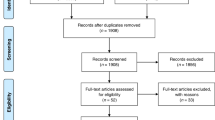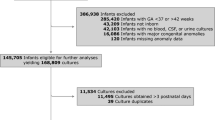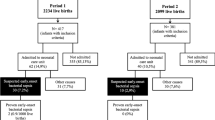Abstract
Background
Umbilical cord blood culture (UCBC) may have a diagnostic utility for early onset sepsis (EOS) detection in preterm infants. It may prevent sampling the newborn and collect a higher volume of blood for pathogenic identification.
Methods
Retrospective analysis at a tertiary care center in Canada of preterm infants ≤ 34 0/7 weeks’ gestation with UCBC taken at birth.
Results
Of 505 admitted infants, 195 had UCBC. 170 UCBCs were negative; 44 of these had also negative neonatal blood culture (NBC). No infants with negative UCBC showed EOS symptoms in the first week of life. 25 UCBCs were positive: 18 were contaminants (all with negative NBC) and 7 were confirmed as EOS. 18 infants with UCBC contaminants remained asymptomatic. 7 EOS cases were identified, with varying bacteriological profiles; 5 displayed sepsis symptoms while 2 were asymptomatic. Risk of EOS increased with prolonged rupture of membranes.
Conclusions
UCBC effectively detected EOS establishing it as a method with possibly better diagnostic performance than NBC in high-risk neonates. Further studies are needed to improve UCBC technique and lower contamination rates.
Impact
-
Umbilical cord blood culture has a higher bacterial identification rate than peripheral venous blood culture for the early identification of early-onset sepsis in preterm infants.
-
Umbilical cord blood cultures that showed no growth were reliable predictors of not developing early onset sepsis.
-
Umbilical cord blood culture should be considered as part of the evaluation for early onset sepsis in the preterm infants.
This is a preview of subscription content, access via your institution
Access options
Subscribe to this journal
Receive 14 print issues and online access
$259.00 per year
only $18.50 per issue
Buy this article
- Purchase on Springer Link
- Instant access to full article PDF
Prices may be subject to local taxes which are calculated during checkout

Similar content being viewed by others
Data availability
Deidentified individual participant data will be made available to researchers who make a methodologically sound proposal. Proposals should be submitted to brahim.bensouda@umontreal.ca.
References
Polin, J. I. et al. Use of umbilical cord blood culture for detection of neonatal bacteremia. Obstet. Gynecol. 57, 233–237 (1981).
Schelonka, R. L. et al. Volume of blood required to detect common neonatal pathogens. J. Pediatr. 129, 275–278 (1996).
Taksande, A. M., Vilhekar, K. Y., Jain, M. & Chitre, D. Pain response of neonates to venipuncture. Indian J. Pediatr. 72, 751–753 (2005).
Courtois, E. et al. Epidemiology and neonatal pain management of heelsticks in intensive care units: epippain 2, a prospective observational study. Int J. Nurs. Stud. 59, 79–88 (2016).
Baer, V. L., Lambert, D. K., Carroll, P. D., Gerday, E. & Christensen, R. D. Using umbilical cord blood for the initial blood tests of VLBW neonates results in higher hemoglobin and fewer RBC transfusions. J. Perinatol. 33, 363–365 (2013).
Rotshenker-Olshinka, K., Shinwell, E. S., Juster-Reicher, A., Rosin, I. & Flidel-Rimon, O. Comparison of hematologic indices and markers of infection in umbilical cord and neonatal blood. J. Matern Fetal. Neonatal. Med. 27, 625–628 (2014).
Puopolo, K. M., Mukhopadhay, S., Frymoyer, A. & Benitz, W. E. The term newborn: early-onset sepsis. Clin. Perinatol. 48, 471–484 (2021).
Puopolo, K. M. et al. Management of neonates born at ≤34 6/7 Weeks’ gestation with suspected or proven early-onset bacterial sepsis. Pediatrics 142, e20182896 (2018).
Puopolo, K. M. et al. Management of neonates born at ≥35 0/7 Weeks’ gestation with suspected or proven early-onset bacterial sepsis. Pediatrics 142, e20182894 (2018).
Greer, R., Safarulla, A., Koeppel, R., Aslam, M. & Bany-Mohammed, F. M. Can fetal umbilical venous blood be a reliable source for admission complete blood count and culture in NICU patients? Neonatology 115, 49–58 (2019).
Connell, T. G., Rele, M., Cowley, D., Buttery, J. P. & Curtis, N. How reliable is a negative blood culture result? Volume of blood submitted for culture in routine practice in a children’s hospital. Pediatrics 119, 891–896 (2007).
Murray, P. R. & Masur, H. Current approaches to the diagnosis of bacterial and fungal bloodstream infections in the intensive care unit. Crit. Care Med. 40, 3277–3282 (2012).
Dierikx, T. H. et al. Umbilical cord blood culture in neonatal early-onset sepsis: a systematic review and meta-analysis. Pediatr. Res. 92, 362–372 (2022).
Mukhopadhyay, S. & Puopolo, K. M. Risk assessment in neonatal early onset sepsis. Semin Perinatol. 36, 408–415 (2012).
Stoll, B. J. et al. Early-onset neonatal sepsis 2015 to 2017, the rise of Escherichia coli, and the need for novel prevention strategies. JAMA Pediatr. 174, e200593 (2020).
Rallis, D., Giapros, V., Serbis, A., Kosmeri, C. & Baltogianni, M. Fighting antimicrobial resistance in neonatal intensive care units: rational use of antibiotics in neonatal sepsis. Antibiotics 12, 508 (2023).
Cotten, C. M. et al. Prolonged duration of initial empirical antibiotic treatment is associated with increased rates of necrotizing enterocolitis and death for extremely low birth weight infants. Pediatrics 123, 58–66 (2009).
Kumar, R. et al. Implementation of a 24-hour empiric antibiotic duration for negative early-onset sepsis evaluations to reduce early antibiotic exposure in premature infants. Infect. Control. Hosp. Epidemiol. 44, 1–6 (2022).
Quinones Cardona, V., Lowery, V., Cooperberg, D., Anday, E. K. & Carey, A. J. Eliminating contamination in umbilical cord blood culture sampling for early-onset neonatal sepsis. Front Pediatr. 9, 794710 (2021).
Funding
No external funding was received for this study.
Author information
Authors and Affiliations
Contributions
Drs Brahim Bensouda, Romain Mandel and Nabeel Ali conceptualized and designed the study, collected data, drafted the initial manuscript, reviewed, and revised the manuscript. Dr Altit reviewed and revised the manuscript. All the authors approved the final manuscript as submitted and agree to be accountable for all aspects of work.
Corresponding author
Ethics declarations
Competing interests
The authors declare no competing interests.
Consent statement
Patient consent was not required for this study.
Additional information
Publisher’s note Springer Nature remains neutral with regard to jurisdictional claims in published maps and institutional affiliations.
Rights and permissions
Springer Nature or its licensor (e.g. a society or other partner) holds exclusive rights to this article under a publishing agreement with the author(s) or other rightsholder(s); author self-archiving of the accepted manuscript version of this article is solely governed by the terms of such publishing agreement and applicable law.
About this article
Cite this article
Bensouda, B., Mandel, R., Altit, G. et al. Umbilical cord blood culture for early onset sepsis in preterm infants. Pediatr Res (2024). https://doi.org/10.1038/s41390-024-03183-7
Received:
Revised:
Accepted:
Published:
DOI: https://doi.org/10.1038/s41390-024-03183-7



